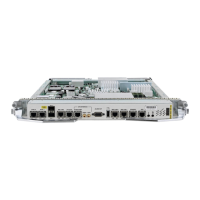The following is an example of an rd-set:
rd-set rdset1
10.0.0.0/8:*,
10.0.0.0/8:777,
10.0.0.0:*,
10.0.0.0:777,
65000:*,
65000:777
end-set
Routing Policy Language Components
Four main components in the routing policy language are involved in defining, modifying, and using policies:
the configuration front end, policy repository, execution engine, and policy clients themselves.
The configuration front end (CLI) is the mechanism to define and modify policies. This configuration is then
stored on the router using the normal storage means and can be displayed using the normal configuration
show commands.
The second component of the policy infrastructure, the policy repository, has several responsibilities. First,
it compiles the user-entered configuration into a form that the execution engine can understand. Second, it
performs much of the verification of policies; and it ensures that defined policies can actually be executed
properly. Third, it tracks which attach points are using which policies so that when policies are modified the
appropriate clients are properly updated with the new policies relevant to them.
The third component is the execution engine. This component is the piece that actually runs policies as the
clients request. The process can be thought of as receiving a route from one of the policy clients and then
executing the actual policy against the specific route data.
The fourth component is the policy clients (the routing protocols). This component calls the execution engine
at the appropriate times to have a given policy be applied to a given route, and then perform some number of
actions. These actions may include deleting the route if policy indicated that it should be dropped, passing
along the route to the protocol decision tree as a candidate for the best route, or advertising a policy modified
route to a neighbor or peer as appropriate.
Routing Policy Language Usage
This section provides basic routing policy language usage examples. See the How to Implement Routing
Policy, on page 618 for detailed information on how to implement routing policy language.
Pass PolicyPass Policy
The following example shows how the policy accepts all presented routes without modifying the routes.
route-policy quickstart-pass
pass
end-policy
Cisco ASR 9000 Series Aggregation Services Router Routing Configuration Guide, Release 5.3.x
553
Implementing Routing Policy
Routing Policy Language Overview

